You’ve got your dirt bike ready and the helmet, the protective gear, and the boots on. But there’s one more important part of your dirt biking outfit you may have not thought about: a dirt bike backpack.
Dirt bike backpacks and fanny packs are called as dirt bike hydration packs. A dirt bike hydration pack has a water bladder inside and a drinking tube attached to it. Most hydration packs hold between 1 to 3 liters of water. Usually, they also have room for other small items you want to pack with you for a ride. You carry a dirt bike hydration pack on your back or on your waist just like a regular backpack or a fanny pack. A good dirt bike backpack or fanny pack will give you an easy access to water without weighing you down or getting in your way as you ride.
After testing several dirt bike backpacks and fanny packs, we want to share few pointers and options for riders looking for adding better hydration methods to their dirt bike riding.
This post contains affiliate links. If you use these links to buy something we may earn a commission at no additional cost to you. As an Amazon Affiliate we earn from qualifying purchases.
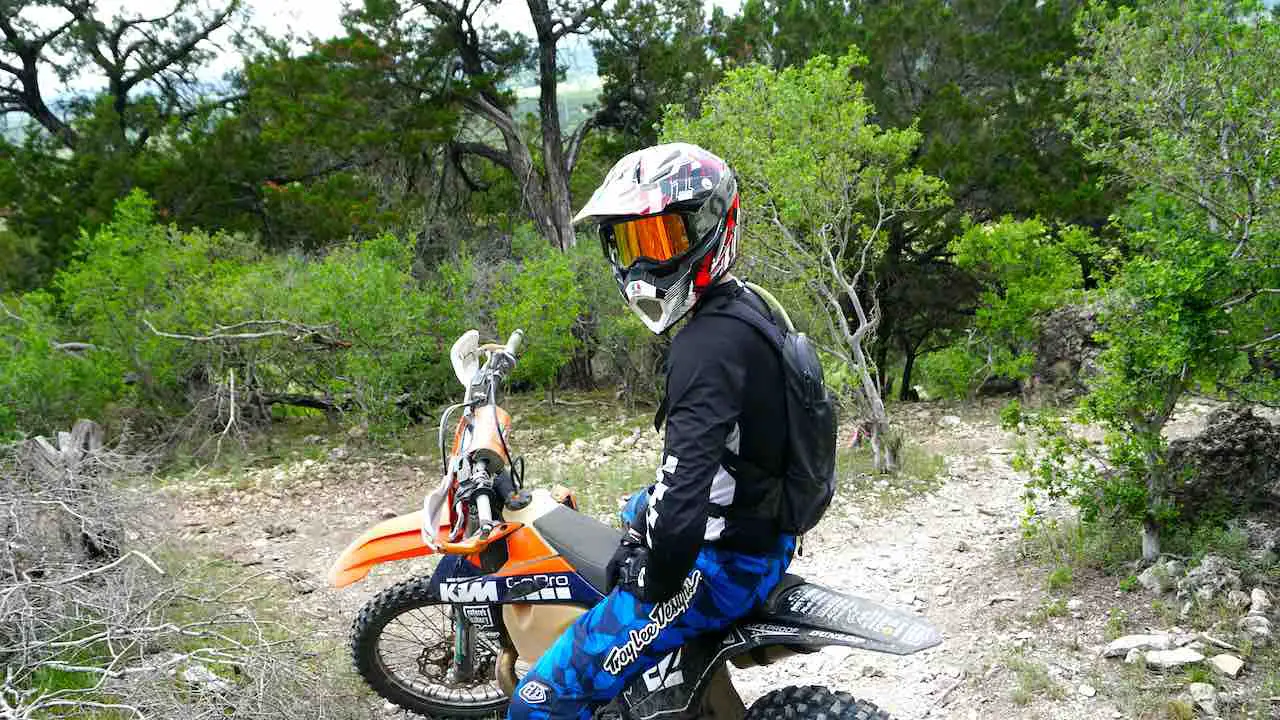
Benefits of Using a Dirt Bike Backpack
Dirt bike riding is a strenuous sport. Therefore, proper hydration is important and can help to fight fatigue and increase your performance and recovery.
But carrying all that water and critical items with you can be challenging. The protective gear limits the ways for carrying the water and the amount of water you can carry with you. You can always carry water bottles in a backpack, but if you’re not careful they’ll slosh all over the place as you ride. And in most cases, strapping tools or water to your dirt bike is not the best option.
A good dirt bike backpack or fanny pack will give you an easy access to water on the trails without weighing you down or getting in your way. A dirt bike hydration pack gives you the option to sip water on the go without needing to stop and remove a water bottle from a backpack. With a dirt bike hydration pack you just grab the drinkin tube, bite down and you’re good to go. This extra convenience means that you are able to drink more water and stay hydrated without even realizing it.
With a good planning, you can carry 1 to 3 liters of water plus all the critical tools and a phone with you without feeling uncomfortable on the trails. Your options are either using a dirt bike backpack or a dirt bike fanny pack (also known as waist pack or hip pack). They both come with multiple variations both in terms of the size and form.
Next, let’s explore dirt bike backpacks and fanny packs further and go through our experiences with these hydration packs.
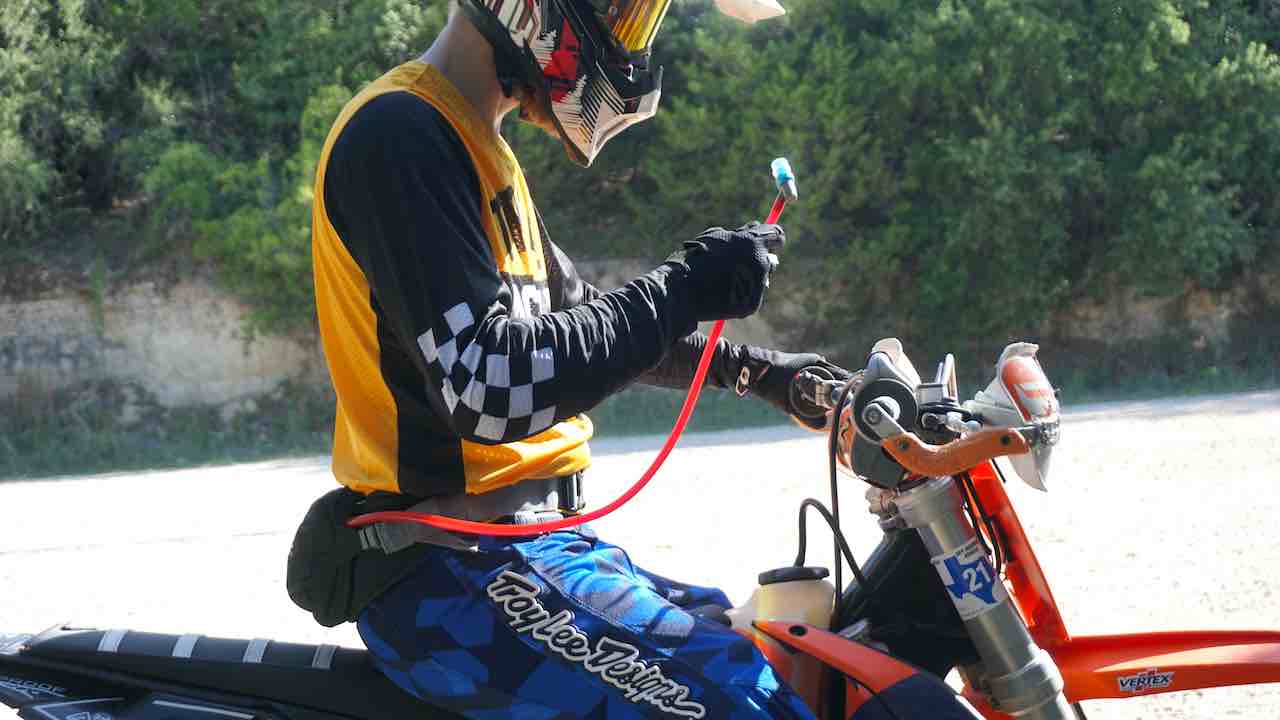
Choose a Hydration Pack That Fits Your Needs and Riding Style
Your riding style and the trails you ride on can help you to decide whether to choose a dirt bike backpack or a dirt bike fanny pack. The amount of water and extra space determines the ideal use of the dirt bike hydration pack.
Dirt bike backpacks generally provide more storage and they can carry much more water than fanny packs. They offer various pockets and areas specifically designed to carry tools, phones, and snacks, while still fitting a bigger water pouch inside for added water storage.
Dirt bike backpacks usually mention the amount of water the inner water bladder holds and the total volume for other items. For example, a 6-liter backpack may have a 2-liter water bladder and 4 liters of extra space for the rest of the stuff you want to carry on your dirt bike.
Dirt bike fanny packs, on the other hand, generally can carry slightly less water and tools. Depending on the model and style, they usually carry water in the range of 0.50 to 1.50 liters. Some focus on hydration and snacks only, while other models combine a separate section for spare tools and other items and still contain a moderate amount of water inside the bladder. Other options also include separate water bottle mounts for extended water capacity or as the primary method for carrying hydration.
Both dirt bike hydration pack styles offer similar drinking methods. Usually, the water bladder has a hose and a drinking tube attached to it. These are then routed onto the outside of the storage area. The drinking tube is connected to the front of the rider, either in the shoulder or waist area, where it is easy to pick up for drinking. The drinking tube itself usually has a bite valve or a turn-on/off valve that provides easy access to water.
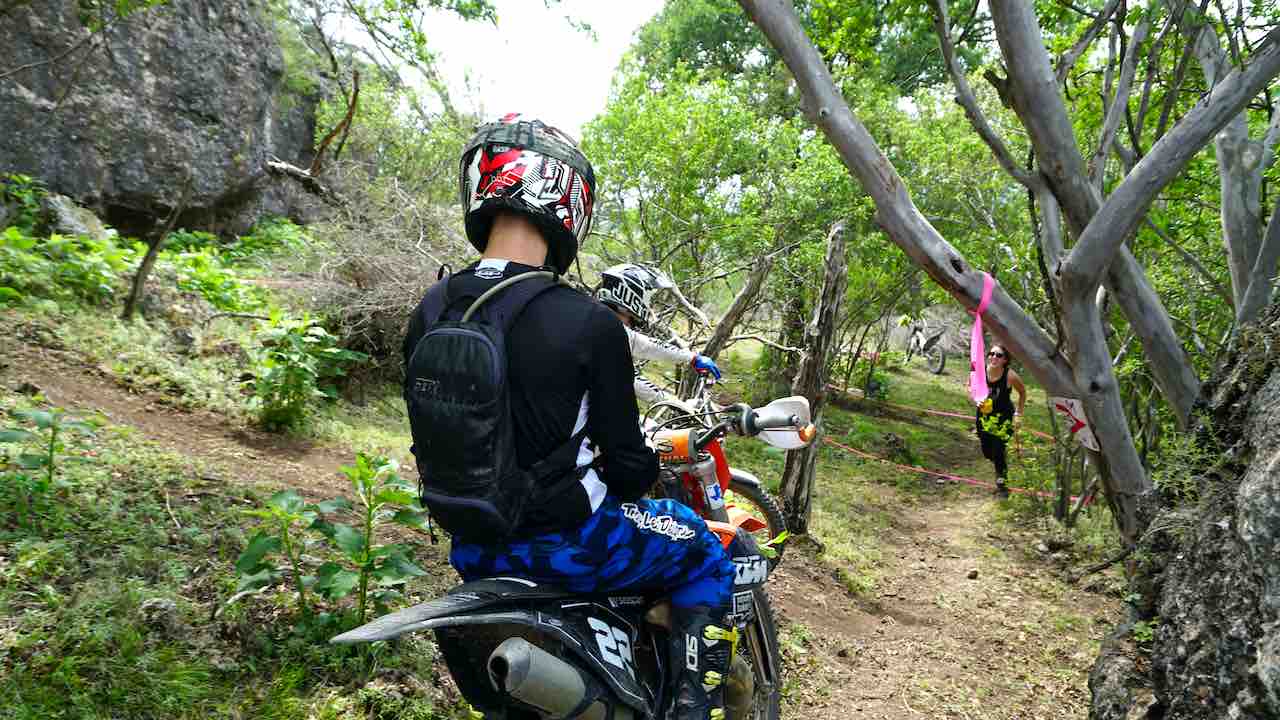
Dirt Bike Backpacks
Dirt bike backpacks or dirt bike camelbaks seem to be very popular among dirt bike riders. They offer extended packing options while carrying more water and other items safely with you.
Dirt bike backpacks generally offer good ergonomics and a good weight distribution without affecting the rider performance. The weight does sit higher than with fanny pack models, however, when properly packed and used the weight is generally unnoticeable while riding.
Both models support a direct installation inside the helmet for a hands-free hydration, although this usually means buying an aftermarket helmet fitment kit.
Things To Look For in a Good Dirt Bike Backpack
- Bladder capacity. How much water do you consume before you are able to refill? Riding in the heat above 80-degrees or so means that riders tend to consume anywhere between 1 to 2 liters per hour out on the trails. This varies a lot but gives you an idea of how much water is needed for your riding style and trails.
- Storage capacity and compartments. If you plan to pack other things beside water, check how the storage is laid out inside the dirt bike backpack. Tools and other heavier items need to be strapped down to keep them from moving around. Throwing your phone inside a backpack with tools is a sure way to break the phone and feel uncomfortable while the tools bounce around the backpack.
- Durability. Dirt biking is a harsh sport for most of the gear you wear and this also applies to dirt bike backpacks. Do you need a waterproof backpack? Consider the things you plan to carry and how durable the backpack is in long-term use. Usually, the water bladder can easily be replaced but how about the rest of the backpack? Can it withstand the conditions you ride in?
- Fitment. How well does the dirt bike backpack fit you? Test them carefully. The best dirt bike backpack is the one that feels comfortable and that you forget you are wearing while on the dirt bike out on the trails.
Pros and Cons of Dirt Bike Backpacks
| PROS | CONS |
|---|---|
| More storage and water capacity | Limits air flow in your back |
| Tube location provides easy access to water | Sits high, uneven weight distribution |
| Lots of size and style options | Can be uncomfortable when wearing a chest plate or back protector |
| Plenty of affordable solutions | Can bounce around quite a lot if fitment is not good |
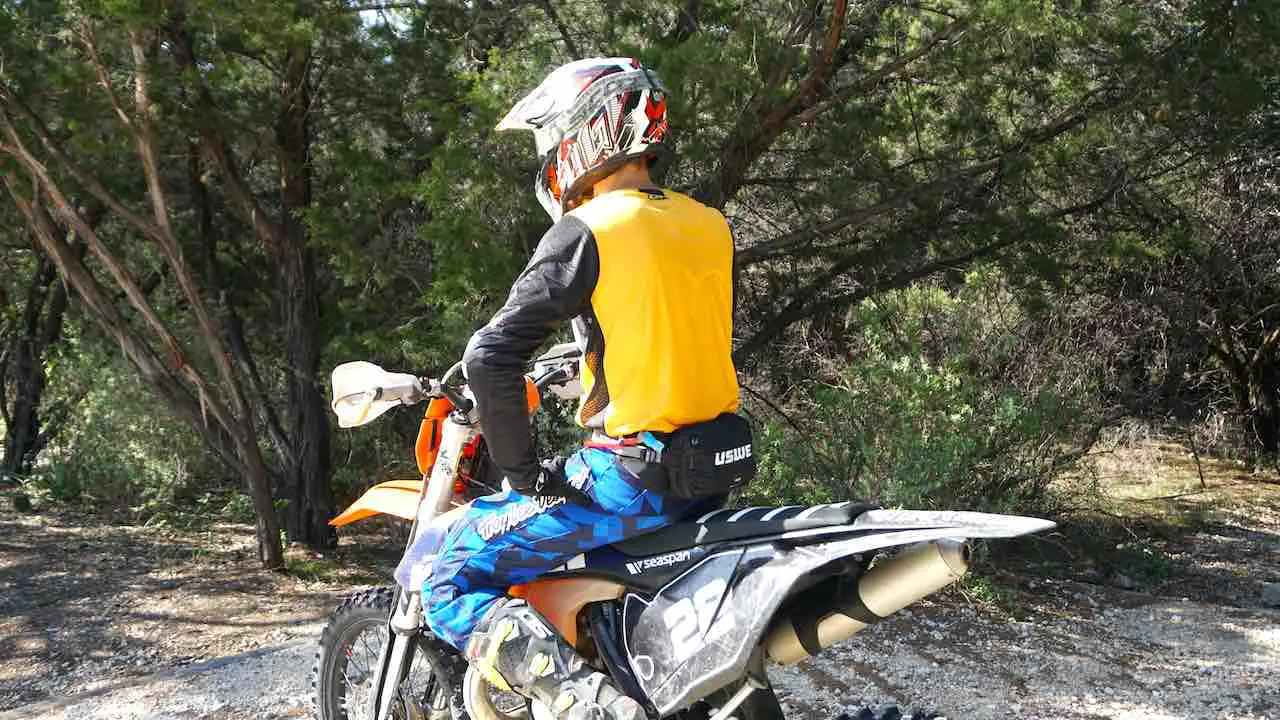
Dirt Bike Fanny Packs
Dirt bike fanny packs (also known as dirt bike waist pack or hip pack) offer similar hydration and storage options as dirt bike backpacks but in a different form.
The fanny back style hydration pack seems to be more popular in Europe and Asia. But it is lately gaining popularity also here in U.S. It’s also popular among mountain bikers and runners.
The main benefits of using a dirt bike fanny pack are comfort and usability. A fanny pack also works great in high heat since it frees your back for better cooling.
The similar aspects compared to a dirt bike backpack apply when selecting the fanny back to your liking. In addition to water and storage carrying capacity, it’s crucial to test the fitment and usability for best results.
The water hose usually wraps around the waist and connects via a hook or a hook with a magnet. This seems to work well and it’s very easy to reach the drinking tube and use it with one hand with gloves on. We have noticed that the water hose in a fanny pack moves less than in most dirt bike backpacks where the water hose is dangling in the shoulder area.
Things To Look For in a Good Dirt Bike Fanny Pack
- Hydration bladder capacity. Dirt bike fanny packs generally carry bladders between 0.50 to 1.5 liters. Some models offer an extra bottle capacity and loops to connect the bottles on the sides. If this is enough, then a fanny pack is a great option for you.
- Storage capacity and compartments. The water bladder usually sits sideways inside the main compartment in a fanny pack. If you are planning to pack tools and other items, check how they are strapped in and separated from the bladder. Tools—especially if loose—would quickly eat through the bladder causing leaks.
- Durability. The same goes for fanny packs as for dirt bike backpacks. While the fanny pack is well protected, it is still a good idea to invest in good materials and check how well the fanny pack will hold the sometimes extreme conditions of dirt bike riding.
- Fitment. Dirt bike fanny packs are held in place only by one strap around the waist. Therefore, it is important to find a fanny back that will be comfortable and does not move. The width and form of the waist band is important and also how the items inside the storage area are strapped in. If you plan to carry tools, make sure they are properly fitted inside and do not move around. Some models are specifically designed with compartments for tools and separate areas for a phone and snacks.
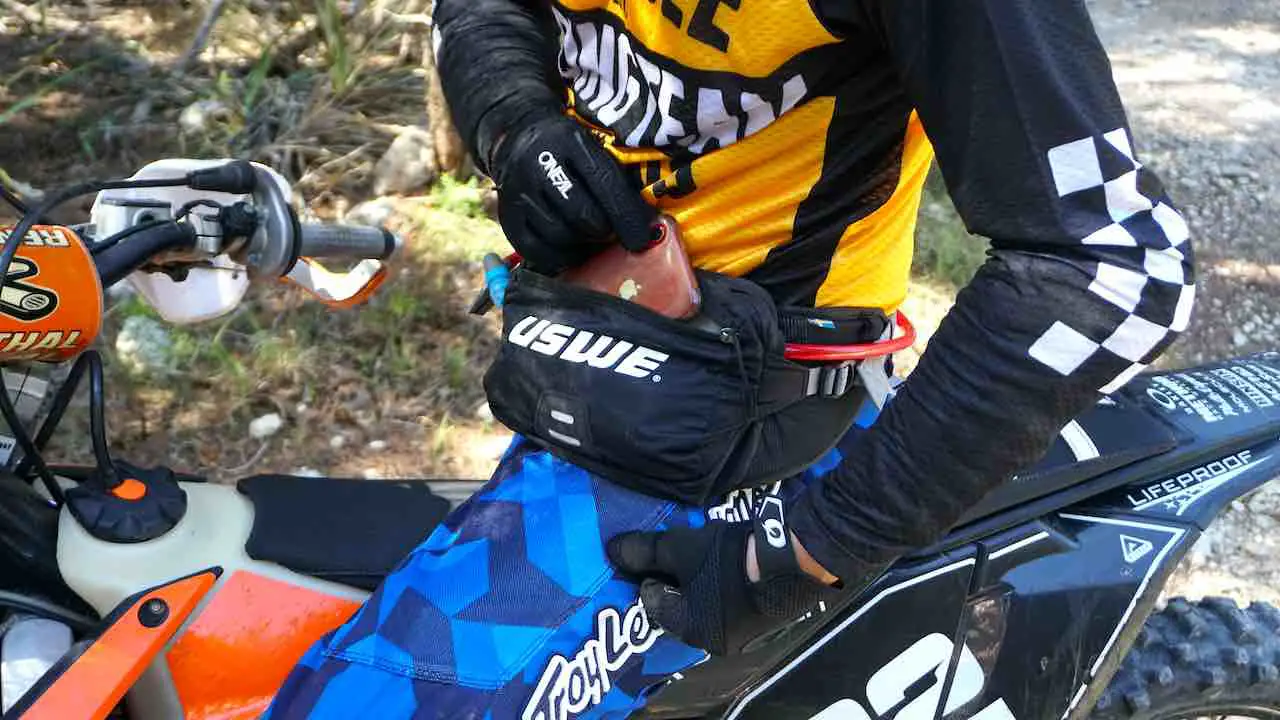
Pros and Cons of Dirt Bike Fanny Packs
| PROS | CONS |
|---|---|
| Generally lighter and smaller in size | Smaller bladder size and storage options |
| Frees the back area for better cooling | May be the pricier option |
| More comfortable to wear | |
| Moves very little and the weight sits low | |
| Quick access by rotating around the waist | |
| Can be worn with a backpack |
Our Recommendations for Dirt Bike Hydration Packs
Staying hydrated and cool is extremely important to us as we ride most of the year in hot weather. We used a dirt bike backpack for a long time and were very happy with it. It’s an excellent way to carry a lot of water with you on the trails and you can also pack some tools and your phone in it. To us, the only downside to a dirt bike backpack is that it can really make you feel hot in the back.
Recently, we started testing dirt bike fanny packs and it was love at first try! Compared to a dirt bike backpack, a hydration fanny back allows for good airflow across the back, which we love. It still has a large enough water bladder to provide hydration for short rides. We usually ride one or two loops and come back to the camp for a minute’s rest so we are able to fill the water bladder often.
Our fanny pack has a magnet attached to the waist and to the drinking tube, so it’s easy to grab the tube with gloves and drink on the go. Another great thing about a fanny back is that you can just slide it to the front when you want to check your phone or grab a snack. We first thought that the fanny back would feel uncomfortable when sitting down or bouncing up and down when riding. But we were positively surprised how you don’t even notice it when riding.
That being said, a hydration fanny pack is definitely our favorite. It works great for enduro dirt biking, trail riding, and short trails.
However, we are not ditching our dirt bike backpack either. There is a time and place for them too. A smaller dirt bike backpack works well for small, more aggressive rides and for races. And full size dirt bike backpacks are great for longer rides when you need to pack more water, snacks, and tools.
Below are our dirt bike hydration pack recommendations for different types of riding.
Best Lightweight Dirt Bike Backpack for Short Trails and Races: OGIO Erzberg 1L Hydration Pack
This dirt bike backpack is very light and only focused on hydration. It sits high in the shoulder blade area freeing most of your back for improved cooling. It carries only a 1-liter water bladder in a small compartment that is insulated and thus keeps the water cooler longer. This kind of dirt bike backpack is great for shorter, more aggressive rides and for racing.
Best Full Size Dirt Bike Backpack for Longer Rides: Klim Quench Pak
This dirt bike backpack by Klim is a great option for a full size hydration pack. The 1.5-liter hydration bladder sits low in the storage area. In addition, the backpack also offers plenty of space for dirt bike tools and snacks in other compartments. The comfortable harness system and the innovative extension option for a connected fanny pack (Scramble Pak as they call it) offers great extendability for added storage options.
Best Dirt Bike Fanny Pack for Trail Riding: USWE Zulo Hydration Hip Pack
The USWE Zulo is a fanny pack hydration system. It is a great lightweight option for trail riding. It’s designed to eliminate the weight off your shoulders. This dirt bike fanny pack offers intuitive tool storage with a 2-liter water bladder and clever hose routing options.
This fanny pack is our favorite. After riding with the Zulu for the past 6 months, we can recommend the fanny pack style hydration option, especially for hot weather riding.
Tips for Keeping a Hydration Pack Clean and Fresh
Water bladders inside the dirt bike backpacks and fanny packs can quickly start to smell and grow bacteria, mold, and mildew if you don’t clean and store them properly.
For this reason, you should empty and rinse out the water bladder after each use. So, don’t leave your hydration pack laying in the garage after a ride or store it filled with water. Once you have rinsed out the bladder, run water through the hose and mouth piece. Simply hold the full water bladder up high and squeeze the mouth piece with your fingers so that the water runs through the hose.
You don’t need to clean the water bladder with soap and water after each ride day but washing it a couple times per year is recommended. When you do this, clean the water bladder by hand using hot soapy water and a thorough rinse. You can use a tiny amount of dish soap or natural cleaners, such as lemon juice, baking soda, or vinegar. Also remove the mouthpiece and let the pieces soak in warm soapy water before rinsing and drying. If you’re doing a deep clean, you can use a brush for scrubbing inside the bladder and a long piping to run through the drinking tube.
If the water bladder is starting to smell real bad, you can use a tiny amount of bleach to clean out the funk. Make sure that you rinse the water bladder thoroughly to remove any leftover bleach.
Let the water bladder dry after rinsing and washing it. Hang it up with the cap open until it completely dries out. Letting the water bladder dry completely is very important. Otherwise, there is a risk of unwanted mold or mildew growing during storage.
The best way to avoid any mold and smell is to store your water bladder and the drinking tube in a freezer. Just empty and rinse the bladder, dry it out as much as possible to avoid ice inside the tube, and then stash the water bladder and tube inside the freezer. The next time you go riding, just grab the bladder out the freezer, fill it up with water, and put it in your dirt bike backpack.
Conclusions
A dirt bike backpack or a fanny pack is a great way to stay hydrated while riding on the trails.
Choose the dirt bike hydration pack based on the trails you ride on: longer rides require a larger water bladder and more storage and shorter rides the opposite.
Although we also like dirt bike backpacks, a fanny pack is our favorite as it provides enough water capacity for short trails and allows for good airflow across the back. It’s all we need to survive on the trails in the Texas heat!
Keep riding and stay hydrated!
Read next:
- The best dirt bike gear for hot weather
- Cool it down: the best motorcycle helmet for hot weather and other helmet cooling tips
- Beat the heat: how to modify dirt bike pants for hot weather and summer riding
- Essential dirt bike gear for trail riding
- Single track riding tips for beginners
- Best dirt bike radio options for trail riding
- Arm pump: what is it and how to get rid of it
- 30 dirt bike gifts every rider will want

